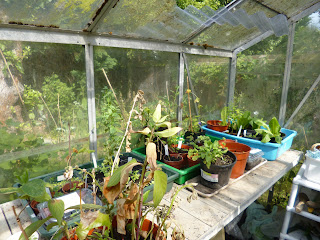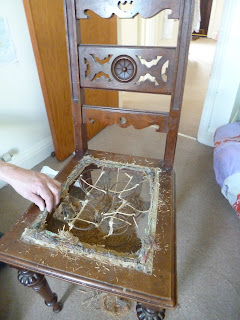 |
| Découpaged table |
Eva Stephen of Home Decor sent me a découpage project that oozes vintage vibes and doesn't cost the earth. I reproduce the text and the accompanying pictures with Eva's permission. If you want to reproduce any of these pictures or the article, please contact Eva through her blog.
Découpage dates back to East Siberian tomb art; the tombs of the deceased from Nomadic tribes were decorated with cut-out pieces of felt. This craft travelled from Siberia to China, where it became commonplace by the 12th century. In China cut-out paper was used to decorate lanterns, windows, boxes and decorative objects. This decorative craft made its way through trading routes from China to Italy in the 17th century.
 To draw forth this ancient craft into the modern world, I paid a visit to Blick, which sells beautiful, handmade paper. It was découpage bliss as I picked out a few lovely pieces to work with.
To draw forth this ancient craft into the modern world, I paid a visit to Blick, which sells beautiful, handmade paper. It was découpage bliss as I picked out a few lovely pieces to work with. My goal was to beautify a hand-me-down my mum gave me, a plain table from Shop4furniture. Here's how I did it:
Materials for découpaging:
• 4-inch sponge brush
• Selection of paper
• Mod Podge (a découpage glue and varnish)
• Measuring tape
• Rag
How to découpage a table:
1. Clean the surface thoroughly.
2. Cut out the paper pieces according to the size you want them to be. Hint: I smoothed down the corners of the paper around the surface I needed them to fit in order to create a bend I could follow when cutting.
3. Arrange the paper pieces and make sure they fit the way you’d like them to.
4. Apply Mod Podge to the back of the paper.
5. Apply the paper pieces to the table, one piece at a time.
6. Smooth each piece of paper with your hand, starting in the middle and working toward the edges.
7. Take your sponge brush and start brushing on a medium thick coat of Mod Podge in large brush strokes all over it. Be careful, do not to be too rough if using delicate paper.
8. Allow the table to dry, according to bottle instructions. Apply a second coat if necessary.
Voila'... Love your home for less has always been my motto - I believe anything can be made beautiful if you put your heart and soul in it!
PS: here's an old découpage of mine, a cardboard box... in hindsight I recommend using several coat of varnish as it's starting to crumble at the edges.




































